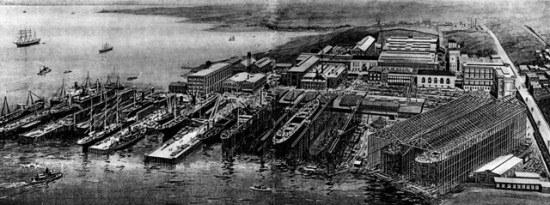From Union to Bethlehem to BAE
By William J. Perez — President and CEO, Bethlehem Shipyard Museum with contributions by Carl Nolte — Chairman and CEO, National Liberty Ship Memorial, Inc.
 Union Brass & Iron Works, commonly known as Union Iron Works, began as a small blacksmith shop at First and Mission streets in San Francisco.
Union Brass & Iron Works, commonly known as Union Iron Works, began as a small blacksmith shop at First and Mission streets in San Francisco.
It was founded in 1849 by two Irish immigrant brothers, Peter and James Donahue. The brothers were known as the Iron Men, and they soon expanded into a machine shop, boiler works and foundry. Maritime operations were performed at Steamboat Cove near the present-day location of AT&T Park.
Peter Donahue saw great potential in the transport industry as a result of the mining booms (gold 1848-55, silver 1859-74) and moved the company into the repair and construction of locomotives in the 1850s. Peter Donahue sold Union Iron Works in 1864, and with the profits he founded San Francisco’s first gas works, later to become Pacific Gas & Electric.
Union Iron Works continued under the able leadership of Irving M. Scott, whom Peter Donahue had recruited as an engineer years earlier. Irving Scott put his brother, Henry Tiffany Scott, in charge of business operations and together they steered the company into the expanding ship building industry. It was a major change of direction; Union Iron Works had spent years producing agricultural, railroad and mining equipment, including much of the machinery used in the Comstock Lode silver discovery in Nevada. In 1883, they moved to the Pier 70 area on land reclaimed from the bay.
In July 1891, Irving Scott embarked upon a whirlwind 25 day tour of the best shipyards in Europe. In a New York Times article dated August 30, 1891, he lamented how far behind the Union Iron Works shipyard, known as America’s best, was when compared to its European competitors.
Upon his return, he invested heavily in creating a state-of-the-art facility where self-sufficiency and efficient work flow were the main focus. He improved the productivity of his workforce by recruiting skilled workers from abroad, mostly Scotland, and created a four-year apprenticeship program for young men. Vindication for Scott came in the form of a June 30, 1899, article in the New York Times, when he proudly proclaimed that “Uncle Sam’s Navy Beats the World” and “battleships much more powerful than the present ones are being built in San Francisco.”
Union Iron Works used a preferential bid-price formula designed by the federal government to encourage shipbuilding on the West Coast to win many contracts from their Eastern rivals.
This yard built the famous cruiser USS Olympia, flagship of Commodore George Dewey’s flotilla at the Battle of Manila Bay during the Spanish-American War in 1898, an engagement that made the United States a world power.
Union Iron Works also built the battleship USS Oregon, whose dash around Cape Horn to join the Atlantic Fleet helped prove the need for a Panama Canal. Two of the first four American submarines were built in this yard. The yard was the first to launch big ships in San Francisco, and the last.
The shipyard built many of the ships that became the Great White Fleet, the symbol of American Naval might that Theodore Roosevelt would send around the globe from 1907 to 1909.
In 1902, the Union Iron Works was absorbed into a combine called the United States Shipbuilding Co. and was caught up in three years of legal battles. In 1905, the 40-acre shipyard was purchased by Bethlehem Steel for $1 million. Charles M. Schwab, who joined Bethlehem from U.S. Steel in 1903, stood on the steps of the Union Iron Works office building on 20th Street during the auction. Many thought it suspicious that Schwab was the only bidder, and some speculated that he had engineered the demise of the collective.
After 1905, the shipyard operated as part of Bethlehem Steel, and produced warships and merchant ships while using the Union Iron Works name until 1917.
The site is still in operation as BAE Shipyards, making it the longest running privately owned shipyard in the United States. The yard employs union labor and is the largest remaining blue-collar operation in San Francisco.
For more information, see Steady as She Goes, the official online newsletter of the National Liberty Ship Memorial, Inc.
